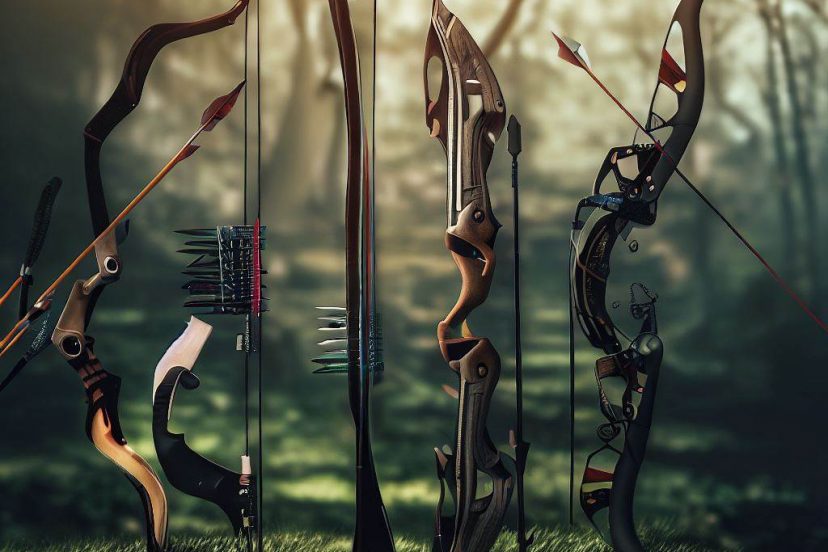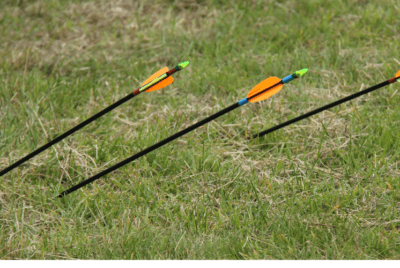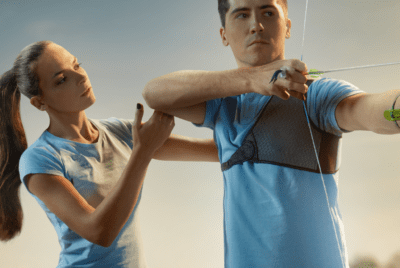Exploring The Perfect Archery Bow: An Overview of Archery Bow Types
"We may earn a commission for purchases made using our links. Please see our disclaimer to learn more."
Introduction
Whether you are a beginner just starting your archery journey or an experienced archer looking to explore new possibilities, understanding the different types of bows available is crucial. In this article, I will walk you through the various archery bow types, their unique characteristics, and provide helpful suggestions to assist you in selecting the perfect bow for your needs.
Recurve Bows
Recurve bows are a popular choice among archers due to their versatility and historical significance. These bows feature curved limbs that bend away from the archer when drawn, allowing for increased power and accuracy. The recurve design enhances energy storage and transfer, making them efficient and effective for target shooting, hunting, and even Olympic competitions.
There are several subtypes of recurve bows available, each tailored to specific archery disciplines and individual preferences. Olympic recurve bows, for instance, prioritize stability and precision, while traditional recurve bows often embrace simplicity and elegance. Recurve bows are known for their ease of use, smooth shooting experience, and wide range of accessories available for customization.
Compound Bows
If you are seeking cutting-edge technology and unparalleled performance, compound bows are the way to go. These bows utilize a system of cams, pulleys, and cables to reduce the holding weight at full draw, allowing for a more comfortable and steady aim. Compound bows are known for their exceptional power, speed, and accuracy, making them popular among hunters and competitive archers.
The intricate components of compound bows contribute to their unique features. The let-off mechanism, for example, enables archers to hold the bow at full draw with reduced effort, making it easier to aim and maintain accuracy. Additionally, the adjustable draw length and weight settings accommodate archers of varying sizes and strengths, ensuring a personalized and optimized shooting experience.
Longbows
Longbows hold a special place in the history of archery, with their roots tracing back to ancient times. These bows have a traditional design, characterized by a simple and unrefined shape. Longbows are typically made from a single piece of wood, allowing for a smooth draw and natural shooting experience. They embody a sense of tradition, simplicity, and elegance that appeals to many archery purists and enthusiasts.
Longbows are renowned for their impressive range and accuracy. Their longer length, when compared to other bow types, provides greater power and stability. The shooting technique with a longbow requires practice and skill, as it involves drawing the bowstring back to the corner of the mouth, a technique known as “anchoring.”
While longbows may lack the technological advancements found in modern compound bows, they offer a unique connection to archery’s historical roots. Many archers appreciate the challenge and sense of accomplishment that comes with mastering the longbow, making it a popular choice for traditional archery enthusiasts and historical reenactments.
Crossbows
For those seeking an alternative to traditional bows, crossbows offer a distinct shooting experience. Crossbows feature a horizontal bow-like assembly mounted on a stock, allowing for increased stability and ease of aiming. Unlike other bows that require continuous effort to hold at full draw, crossbows have a mechanical mechanism that locks the string in place, enabling archers to aim and shoot with reduced physical exertion.
Crossbows are valued for their accuracy, power, and versatility. They are particularly well-suited for individuals with physical limitations, as they require less strength to operate. Crossbows have found applications in hunting, target shooting, and even military use throughout history. Their design allows for longer holding times, making them advantageous for hunters in stealthy situations.
Hybrid Bows
In recent years, the concept of hybrid bows has gained traction among archery enthusiasts. These bows combine features from different bow types to create a versatile and well-rounded shooting experience. Hybrid bows often incorporate elements from recurve bows and compound bows, taking advantage of the recurve’s smooth draw and the compound’s advanced technology.
By blending different technologies and design principles, hybrid bows aim to offer archers the best of both worlds. These bows may feature recurve limbs with a compound-style cam system, providing increased power and accuracy while maintaining a comfortable shooting experience. Hybrid bows cater to archers who appreciate innovation and seek a bow that adapts to various shooting scenarios.
Traditional vs. Modern Bows
When choosing a bow, you’ll encounter a decision between traditional and modern bows. Traditional bows encompass longbows, recurve bows, and their variants, while modern bows primarily refer to compound bows and crossbows.
Traditional bows carry a sense of nostalgia and connection to archery’s roots. They embody simplicity, relying on the archer’s skill and technique to achieve accuracy. Traditional bows offer a rewarding shooting experience but may require more practice to master. On the other hand, modern bows, such as compound bows and crossbows, leverage advanced technology and design to enhance performance and accuracy. They often provide adjustable settings, accessories, and increased power, appealing to those seeking precision and efficiency.
The choice between traditional and modern bows ultimately depends on personal preferences, shooting style, and intended use. Traditional archers may value the simplicity and historical significance of traditional bows, while others may prefer the cutting-edge technology and performance of modern bows.
Selecting the Right Archery Bow Types
When selecting a bow, it’s essential to consider several factors to ensure the perfect fit for your needs. Here are some key considerations:
- Experience Level: Beginners may find recurve bows or compound bows with adjustable settings more forgiving and easier to shoot, while experienced archers may appreciate the challenge of mastering traditional or hybrid bows.
- Purpose: Determine the primary use of the bow. Are you interested in target shooting, hunting, or competitive archery? Different bow types excel in specific disciplines.
- Budget: Consider your budgetary constraints. Traditional bows and entry-level compound bows tend to be more affordable, while high-end compound bows and specialized bows can be quite expensive. Ensure that you strike a balance between your budget and the features you desire.
- Draw Weight and Length: It’s crucial to choose a bow with an appropriate draw weight and length for your physical abilities. Consult with a knowledgeable archery professional who can assist you in determining your optimal specifications.
- Comfort and Fit: Try out different bow models to find one that feels comfortable and suits your body proportions. The grip, weight distribution, and overall feel of the bow should align with your shooting style.
- Accessories and Customization: Consider the availability of accessories and customization options for the bow you choose. Accessories like sights, stabilizers, arrow rests and quivers can enhance your shooting experience and accuracy.
Remember, selecting the right bow is a personal choice. Take your time, seek advice from experienced archers, and try out different bows before making a decision.
Maintenance and Care
To ensure optimal performance and longevity of your bow, proper maintenance and care are essential. Here are some maintenance tips:
- Regular Inspections: Regularly inspect your bow for any signs of damage or wear. Check the limbs, strings, cables, and other components for any cracks, fraying, or loose parts.
- String Care: Clean and wax the bowstring regularly to prevent fraying and extend its lifespan. Follow manufacturer guidelines for waxing frequency and use.
- Storage: Store your bow in a cool, dry place, away from direct sunlight and extreme temperatures. Consider using a bow case or bag to protect it from dust and impacts.
- String Replacement: Bowstrings wear out over time and may need to be replaced. Consult a professional bow technician to ensure proper string installation and tuning.
- Limbs and Riser Care: Keep the limbs and riser clean by gently wiping them with a soft cloth. Avoid exposing the bow to excessive moisture or abrasive substances.
- Arrow Maintenance: Inspect and maintain your arrows regularly. Check for straightness, replace damaged or broken arrows, and ensure proper nock and fletching alignment.
By following these maintenance practices, you can prolong the lifespan of your bow and ensure consistent performance.
Conclusion
In conclusion, the world of archery bow types offers a wide range of options to cater to every archer’s preferences and needs. Whether you prefer the simplicity and elegance of traditional bows, the cutting-edge technology of compound bows, the historical significance of longbows, the versatility of crossbows, or the innovation of hybrid bows, there is a perfect bow waiting for you.
Consider your experience level, purpose, budget, and shooting style when selecting a bow. Take the time to try out different models, seek guidance from professionals, and find the bow that feels comfortable and suits your needs.
With proper maintenance and care, your bow will serve you well throughout your archery journey, providing countless hours of joy, challenges, and rewarding experiences.
So, go forth, choose your bow wisely, and embark on an exciting archery adventure that will bring you joy, challenge, and a deep appreciation for the art of bowmanship. Happy shooting!
FAQ
Q1. What is the best bow type for a beginner?
A: For beginners, recurve bows or entry-level compound bows with adjustable settings are often recommended due to their forgiving nature and ease of use.
Q2. Are compound bows suitable for hunting?
A: Yes, compound bows are widely used for hunting due to their power, accuracy, and let-off mechanism that allows for longer holding times while aiming.
Q3. Can I use a crossbow for target shooting?
A: Absolutely! Crossbows can be used for target shooting, and their stable shooting platform and reduced physical exertion make them advantageous for extended practice sessions.
Q4. Are traditional bows more challenging to shoot than modern bows?
A: Traditional bows require more practice and skill to master, as they rely on the archer’s technique and consistent form. Modern bows, such as compound bows, often have features and technology that make them more forgiving and easier to shoot accurately.
Q5. Can I customize my bow with accessories?
A: Yes, many bow types allow for customization with various accessories. You can enhance your shooting experience by adding accessories such as sights, stabilizers, arrow rests, and quivers to suit your preferences and shooting style.
Q6. How often should I wax my bowstring?
A: The frequency of waxing your bowstring depends on factors such as usage and environmental conditions. As a general guideline, it is recommended to wax the bowstring every few months or whenever it starts to appear dry or show signs of fraying.





